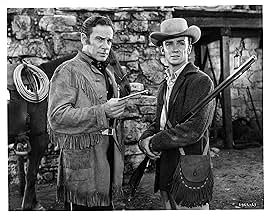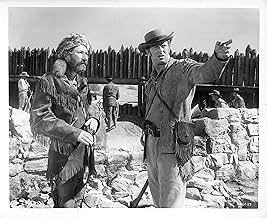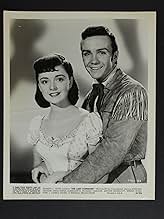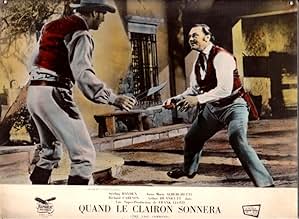IMDb रेटिंग
6.2/10
1 हज़ार
आपकी रेटिंग
अपनी भाषा में प्लॉट जोड़ेंModerate Jim Bowie leads rebellious Texicans--and Davy Crockett--in a last-ditch stand against his old friend, Santa Ana.Moderate Jim Bowie leads rebellious Texicans--and Davy Crockett--in a last-ditch stand against his old friend, Santa Ana.Moderate Jim Bowie leads rebellious Texicans--and Davy Crockett--in a last-ditch stand against his old friend, Santa Ana.
- निर्देशक
- लेखक
- स्टार
Abdullah Abbas
- Townsman
- (बिना क्रेडिट के)
Rico Alaniz
- Tomas
- (बिना क्रेडिट के)
फ़ीचर्ड समीक्षाएं
Studio politics prevented John Wayne from getting the role he coveted.Wayne would have to wait nearly a decade before he would put his own vision of the Alamo on the silver screen. The film is magnificent and told remarkable for its era (a) with a recognition that Mr Bowie having married into the Mexican elite had become an assimilato, a naturalized Mexicano, (b) with sympathy for the Mexican viewpoint and (c) with respect for General Santa Ana.
The Travis of this version is not nearly the superbly arrogant martinet of the Wayne film nor the dummy who matures in combat of the more recent edition.
Regrettably unlike the Wayne film, this version omits the heroine of the story who knitted the Alamo flag-- the Mexican tricolor with the legend 1824 for the liberal constitution for which the Texans fought. Cut off by the Mexicans, the Alamo defenders would never have known of the declaration of independence or the adoption of the Lone Star flag.
Yet as the story of heroism against the odds, Last Command is first rate.
The Travis of this version is not nearly the superbly arrogant martinet of the Wayne film nor the dummy who matures in combat of the more recent edition.
Regrettably unlike the Wayne film, this version omits the heroine of the story who knitted the Alamo flag-- the Mexican tricolor with the legend 1824 for the liberal constitution for which the Texans fought. Cut off by the Mexicans, the Alamo defenders would never have known of the declaration of independence or the adoption of the Lone Star flag.
Yet as the story of heroism against the odds, Last Command is first rate.
Frank Lloyd's career stretched back to the silent era--he was a major director and made films for the top studios in Hollywood. Winding up at a B studio like Republic would seem to be a step down the career ladder, but this film is actually one of Lloyd's best and one of the best to ever come out of Republic.
The studio didn't often get the services of directors of the calibre of Frank Lloyd--although John Ford and Fritz Lang had occasionally made films there--and it spared no expense on this one. The subject matter demanded a big budget, and Republic didn't stint. Thousands of extras, big sets, spectacular action scenes, robust performances--all combined to make a first-rate action picture. Sterling Hayden makes a good Jim Bowie, the always underrated Arthur Hunnicutt personifies Davy Crockett, and the cast is filled with familiar character actors--Roy Roberts, Slim Pickens, John Russell, Jim Davis--who contribute much to the overall atmosphere of the film. The setpiece of the movie, though, is the final siege of the Alamo itself, and it is spectacular. It compares well to the John Wayne version made five years later, and ranks right up there with the final battle scene in 1964's "Zulu"--expertly edited with top-notch stunt-work and special effects. Very highly recommended.
The studio didn't often get the services of directors of the calibre of Frank Lloyd--although John Ford and Fritz Lang had occasionally made films there--and it spared no expense on this one. The subject matter demanded a big budget, and Republic didn't stint. Thousands of extras, big sets, spectacular action scenes, robust performances--all combined to make a first-rate action picture. Sterling Hayden makes a good Jim Bowie, the always underrated Arthur Hunnicutt personifies Davy Crockett, and the cast is filled with familiar character actors--Roy Roberts, Slim Pickens, John Russell, Jim Davis--who contribute much to the overall atmosphere of the film. The setpiece of the movie, though, is the final siege of the Alamo itself, and it is spectacular. It compares well to the John Wayne version made five years later, and ranks right up there with the final battle scene in 1964's "Zulu"--expertly edited with top-notch stunt-work and special effects. Very highly recommended.
Forget any adherence to historical facts, directed by Frank Lloyd and with a Warren Duff screenplay, The Last Command is a slow moving piece that uses Jim Bowie as its focal point. Starring Sterling Hayden (Bowie), Richard Carlson (William Travers), Arthur Hunnicutt (Davy Crockett), Ernest Borgnine (Mike Radin), J. Carrol Naish (Santa Ana), and Anna Maria Alberghetti (Consuela), the piece was a project long courted by John Wayne. However, Republic refused to sanction the type of budget the Duke wanted for his vision. So after offering him a nominal fee for a part, he refused and Republic promptly went on to make the film anyway. The final result is an interesting film that finally pays off for those having the patience and tolerance for patriotic flag waving.
The story follows the battle of the Alamo in San Antonio in 1836, where brave Texans gave their life to become free of the Mexican rule, by defending the former mission station against overwhelming odds as the Mexican army of Santa Ana closed in for victory. The final battle is very well staged by Lloyd, and the acting, though not making the earth move, is very competent, particularly Hayden who does a nice line in tortured ruggedness. Max Steiner provides a zippy score and the low budget use of Trucolor doesn't affect the work of cinematographer Jack Marta. Safe and enjoyable as a story telling piece, if ultimately far from being a rousing spectacle fit for that particular part in history. 6/10
The story follows the battle of the Alamo in San Antonio in 1836, where brave Texans gave their life to become free of the Mexican rule, by defending the former mission station against overwhelming odds as the Mexican army of Santa Ana closed in for victory. The final battle is very well staged by Lloyd, and the acting, though not making the earth move, is very competent, particularly Hayden who does a nice line in tortured ruggedness. Max Steiner provides a zippy score and the low budget use of Trucolor doesn't affect the work of cinematographer Jack Marta. Safe and enjoyable as a story telling piece, if ultimately far from being a rousing spectacle fit for that particular part in history. 6/10
'The Last Command' is a film with a better backstory than the film itself! First batted around Republic Pictures as a potential vehicle for John Wayne, the production was put on the back burner when Wayne decided he wanted total creative control, and decided to produce and direct his own version, with a budget Republic couldn't match.
Republic DID, however, have an arsenal of talent available, and a shooting script, and eventually brought in veteran director Frank Lloyd, who had just come off a ten-year hiatus with 'The Shanghai Story', in 1954. Sterling Hayden, fresh from the cult classic 'Johnny Guitar', and a featured role in Fox's lavish 'Prince Valiant', signed to play Jim Bowie ("I needed the money to refit my boat," he joked). Richard Carlson, whose 'Creature from the Black Lagoon' had just been released by Universal (becoming a big hit) was tapped to play Alamo commander William Barret Travis. Ernest Borgnine, whose 'Marty' was garnering rave reviews (and would earn him an Oscar) took on the showy supporting role of Bowie adversary/friend Mike Radin and starlet Anna Maria Alberghetti, in her first non-singing role, became the female lead. Two veteran character actors rounded out the major cast: J. Carrol Naish, as a sympathetic yet decisive Santa Anna, and, in an offbeat but inspired casting move, bearded Arthur Hunnicutt as a rustic Davy Crockett (who would very nearly steal the film!).
The production was very modestly budgeted, so much so that the number of extras serving as the Mexican army was limited, but director Lloyd and cinematographer Jack Marta were old hands at making more out of less, and with some judicious editing by Tony Martinelli, the illusion of thousands of Mexican soldiers was achieved. Set design was minimal, as well, and the famous 'look' of the church/fortress was often achieved through mat paintings.
Scored by the legendary Max Steiner, with a theme sung by Gordon MacRae, 'The Last Command' seemed to teeter at the edge between 'B' movie and 'A' status; ultimately, the pedestrian script, by Sy Bartlett and Warren Duff, did the movie in, as there was too much time spent on an unnecessary love triangle, which slowed much of the film to a crawl. Despite an unforgettable final battle, audiences avoided the film, and it quickly faded from sight.
Unfortunately, John Wayne didn't learn from 'The Last Command', and he added a love story to his 'Alamo', with the same lethargic result; Crockett's explosive demise (historically inaccurate, but rousing!) must have impressed him, as well, as he staged an even bigger version of it in his film.
'The Last Command' is a curio, but is enjoyable, for the most part, and the spectacular final assault makes it a must for any action fan's collection!
Republic DID, however, have an arsenal of talent available, and a shooting script, and eventually brought in veteran director Frank Lloyd, who had just come off a ten-year hiatus with 'The Shanghai Story', in 1954. Sterling Hayden, fresh from the cult classic 'Johnny Guitar', and a featured role in Fox's lavish 'Prince Valiant', signed to play Jim Bowie ("I needed the money to refit my boat," he joked). Richard Carlson, whose 'Creature from the Black Lagoon' had just been released by Universal (becoming a big hit) was tapped to play Alamo commander William Barret Travis. Ernest Borgnine, whose 'Marty' was garnering rave reviews (and would earn him an Oscar) took on the showy supporting role of Bowie adversary/friend Mike Radin and starlet Anna Maria Alberghetti, in her first non-singing role, became the female lead. Two veteran character actors rounded out the major cast: J. Carrol Naish, as a sympathetic yet decisive Santa Anna, and, in an offbeat but inspired casting move, bearded Arthur Hunnicutt as a rustic Davy Crockett (who would very nearly steal the film!).
The production was very modestly budgeted, so much so that the number of extras serving as the Mexican army was limited, but director Lloyd and cinematographer Jack Marta were old hands at making more out of less, and with some judicious editing by Tony Martinelli, the illusion of thousands of Mexican soldiers was achieved. Set design was minimal, as well, and the famous 'look' of the church/fortress was often achieved through mat paintings.
Scored by the legendary Max Steiner, with a theme sung by Gordon MacRae, 'The Last Command' seemed to teeter at the edge between 'B' movie and 'A' status; ultimately, the pedestrian script, by Sy Bartlett and Warren Duff, did the movie in, as there was too much time spent on an unnecessary love triangle, which slowed much of the film to a crawl. Despite an unforgettable final battle, audiences avoided the film, and it quickly faded from sight.
Unfortunately, John Wayne didn't learn from 'The Last Command', and he added a love story to his 'Alamo', with the same lethargic result; Crockett's explosive demise (historically inaccurate, but rousing!) must have impressed him, as well, as he staged an even bigger version of it in his film.
'The Last Command' is a curio, but is enjoyable, for the most part, and the spectacular final assault makes it a must for any action fan's collection!
I always liked this Alamo epic better than Wayne's because it moved faster and Sterling Hayden and Arthur Hunnicutt looked like Jim Bowie and Davy Crockett might have been. Hunnicutt's death scene influenced Wayne's in his epic but I'll rate Hunnicutt's an A+ for less "operatic" posing and a more real "I'll take you to hell with me realism. The teeny bopper love angle could've of been dropped though.
क्या आपको पता है
- ट्रिवियाThe melody to "The Ballad of Rock Ridge" from the western spoof Blazing Saddles (1974) is taken almost note for note from this film's "Jim Bowie", sung by Gordon MacRae. Coincidentally, Slim Pickens appears in both films.
- गूफ़When Gen. Santa Ana's cavalry charges toward the Alamo, the tire tracks of the camera truck are visible in front of the horses.
- कनेक्शनFeatured in That's Action (1977)
- साउंडट्रैकJim Bowie
by Sidney Clare and Max Steiner
Sung by Gordon MacRae
A Capitol Recording Artist
Arranged by Van Alexander (uncredited)
टॉप पसंद
रेटिंग देने के लिए साइन-इन करें और वैयक्तिकृत सुझावों के लिए वॉचलिस्ट करें
- How long is The Last Command?Alexa द्वारा संचालित
विवरण
बॉक्स ऑफ़िस
- बजट
- $21,93,939(अनुमानित)
- चलने की अवधि1 घंटा 45 मिनट
- पक्ष अनुपात
- 1.66 : 1
इस पेज में योगदान दें
किसी बदलाव का सुझाव दें या अनुपलब्ध कॉन्टेंट जोड़ें





































